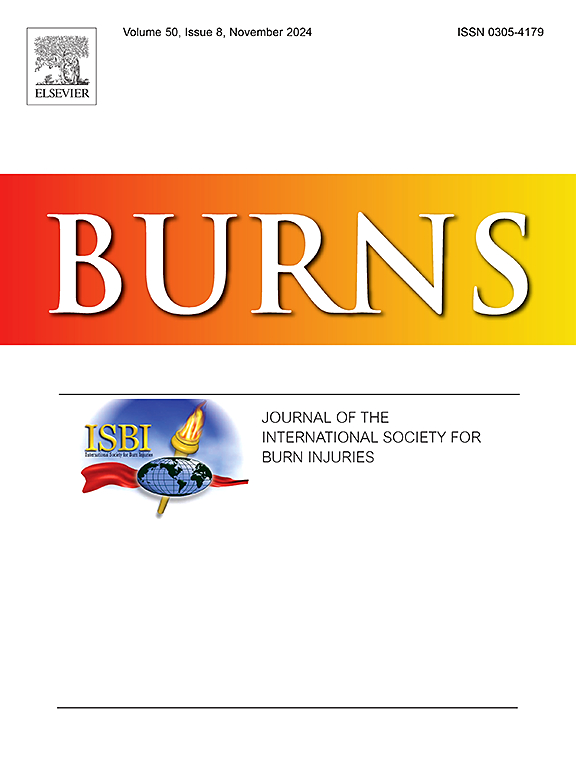Cutaneous functional units (CFUs) versus total body surface area burned (TBSA) for predicting range of motion outcomes: A comparison of predictive models
IF 2.9
3区 医学
Q2 CRITICAL CARE MEDICINE
引用次数: 0
Abstract
Introduction
Motion-limiting scar contractures are a common and functionally impactful complication after burn injury, but predicting their development remains difficult. While total body surface area (TBSA) burned is a standard metric for burn extent and severity, it does not consider burn location, an important factor impacting joint-level motion. Cutaneous functional units (CFUs) offer a more location-specific and functionally relevant assessment of burn injury characteristics, yet their predictive value for motion outcomes remains underexplored. This study validated clinical prediction models incorporating CFUs and TBSA, separately and together, to compare their predictive performance for motion outcomes after burn injury.
Methods
Using data from two multi-center studies, we compared the performance of predictive models with CFU, TBSA, and CFU+TBSA. Fractional regression was used to model range of motion as a function of predictors. Models were internally validated using 10-fold cross-validation on a training dataset and externally validated with an independent testing dataset. Discrimination and calibration were evaluated.
Results
The CFU+TBSA model demonstrated the highest discriminatory power (0.7675; 95 % CI: 0.7497–0.79323), which was only slightly higher than the CFU model (0.7673; 95 % CI: 0.7497–0.7915) in the training dataset. Both the CFU and CFU+TBSA models statistically outperformed the TBSA model (0.7558; 95 % CI: 0.7366–0.7914). Validation in an external dataset revealed lower discrimination for all three models (C-statistic 0.6196–0.6322) and no difference between the models. The discriminatory power of all three models improved when analyzing only finger and thumb observations in the training dataset (C-statistic 0.7952–0.8087), with the CFU and CFU+TBSA models again significantly outperforming TBSA.
Conclusion
Models using CFUs demonstrated better predictive performance than the TBSA-only model, indicating that CFUs enhance predictive value for normalized joint-level motion outcomes at hospital discharge. They appear to have particular utility with hand burns. CFUs offer a more granular, location-specific, and functionally relevant assessment than TBSA alone.
皮肤功能单位(CFUs)与烧伤总面积(TBSA)预测运动范围结果的比较
限制运动的瘢痕挛缩是烧伤后常见且影响功能的并发症,但预测其发展仍然很困难。虽然烧伤总面积(TBSA)是衡量烧伤程度和严重程度的标准指标,但它没有考虑烧伤位置,而烧伤位置是影响关节水平运动的重要因素。皮肤功能单位(cfu)提供了更具体的位置和功能相关的烧伤特征评估,但其对运动结果的预测价值仍未得到充分探讨。本研究验证了合并cfu和TBSA的临床预测模型,分别和一起比较了它们对烧伤后运动结果的预测性能。方法利用两项多中心研究的数据,比较CFU、TBSA和CFU+TBSA预测模型的性能。分数回归用于模拟运动范围作为预测因子的函数。模型内部使用训练数据集上的10倍交叉验证进行验证,外部使用独立测试数据集进行验证。对鉴别和校准进行了评价。结果CFU+TBSA模型在训练数据集中表现出最高的判别能力(0.7675;95 % CI: 0.7497 ~ 0.79323),仅略高于CFU模型(0.7673;95 % CI: 0.7497 ~ 0.7915)。CFU和CFU+TBSA模型在统计学上均优于TBSA模型(0.7558;95 % CI: 0.7366-0.7914)。在外部数据集的验证表明,所有三种模型的歧视程度较低(c -统计量为0.6196-0.6322),模型之间没有差异。当只分析训练数据集中的手指和拇指观察值时,这三种模型的区分能力都有所提高(c统计量为0.7952-0.8087),CFU和CFU+TBSA模型的区分能力再次显著优于TBSA。结论使用cfu的模型比仅使用ttbsa的模型具有更好的预测效果,表明cfu增强了对出院时标准化关节水平运动结果的预测价值。它们似乎对手部烧伤特别有用。与单独的TBSA相比,cfu提供了更细粒度、位置特定和功能相关的评估。
本文章由计算机程序翻译,如有差异,请以英文原文为准。
求助全文
约1分钟内获得全文
求助全文
来源期刊

Burns
医学-皮肤病学
CiteScore
4.50
自引率
18.50%
发文量
304
审稿时长
72 days
期刊介绍:
Burns aims to foster the exchange of information among all engaged in preventing and treating the effects of burns. The journal focuses on clinical, scientific and social aspects of these injuries and covers the prevention of the injury, the epidemiology of such injuries and all aspects of treatment including development of new techniques and technologies and verification of existing ones. Regular features include clinical and scientific papers, state of the art reviews and descriptions of burn-care in practice.
Topics covered by Burns include: the effects of smoke on man and animals, their tissues and cells; the responses to and treatment of patients and animals with chemical injuries to the skin; the biological and clinical effects of cold injuries; surgical techniques which are, or may be relevant to the treatment of burned patients during the acute or reconstructive phase following injury; well controlled laboratory studies of the effectiveness of anti-microbial agents on infection and new materials on scarring and healing; inflammatory responses to injury, effectiveness of related agents and other compounds used to modify the physiological and cellular responses to the injury; experimental studies of burns and the outcome of burn wound healing; regenerative medicine concerning the skin.
 求助内容:
求助内容: 应助结果提醒方式:
应助结果提醒方式:


